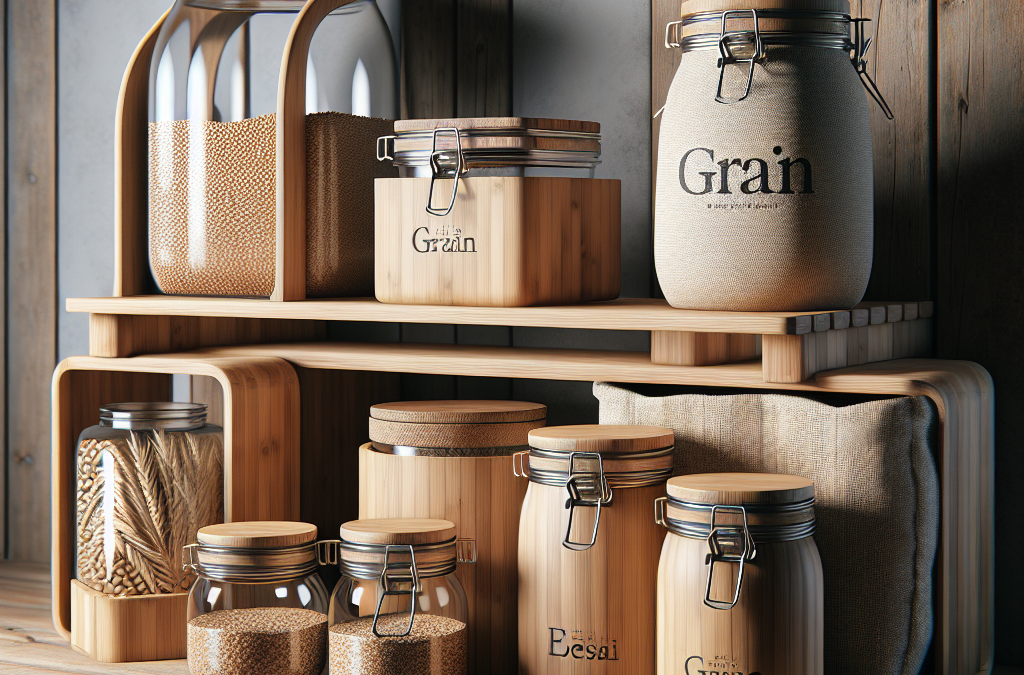Understanding the Basics of Grain Storage
Why Grain Storage Matters
Let’s kick this off by talking about why we even bother with grain storage in the first place. I mean, we all love our organic grains, right? Proper storage is crucial not only for preserving the quality of the grains but also for minimizing waste. When grains get damaged or infested, that’s a direct hit to your wallet and your eco-friendliness.
Furthermore, storing your grains correctly can significantly extend their shelf life. I’ve learned this the hard way—nothing is worse than opening up a sealed bag of quinoa only to find it rancid. By understanding what’s at stake, we can ensure our prized pantry items stay fresh and delicious.
So, make it a point to recognize the importance of storing grains properly. It’s about sustainability, saving money, and keeping your meals wholesome and nourishing for your family.
Choosing the Right Containers
You can’t just throw your grains into any ol’ container, my friends! The right storage containers play a huge role in keeping those ingredients fresh. Personally, I prefer glass or BPA-free plastic containers because they seal tightly and keep pests out. I’ve seen some solid options at the local thrift store; who says you have to break the bank?
It’s also great to label your containers! Trust me, nothing is worse than having a cabinet full of unlabeled jars. Make it a little fun—use different colors for whole grains, flours, and legumes. It makes cooking so much easier and definitely more aesthetically pleasing!
Lastly, consider the size of your household. I often recommend going for a few larger containers for bulk storage, but also invest in smaller ones for daily use. This way, you can minimize the time you’re opening and closing containers and keep your grains fresher for longer.
Best Practices for Grain Storage
Now that you’ve got the containers, it’s time to dig into the best practices. Temperature plays a significant role in grain storage. I keep mine in a cool, dark place, away from sunlight and moisture. Heat can cause grains to spoil, while moisture can lead to mold. So, you see, location matters!
Another tip: periodically check on your stored grains. Just because they’re in a sealed jar doesn’t mean they’re invincible. Every few months, I give mine a little look-see, and I can’t stress enough: if you see any signs of spoilage, it’s best to toss them. Don’t take a chance!
Finally, don’t mix old and new grains. If I buy a new sack of rice, I make sure to label it and keep it separate from the older stuff. Older grains might have a slightly different texture or taste, and you don’t want a hodgepodge of textures mucking up your meal prep.
Utilizing Natural Preservatives
Understanding Natural Preservatives
Did you know that you can actually use natural preservatives to extend the life of your grains? To be honest, I wasn’t fully aware until I stumbled upon this nifty trick during one of my many pantry cleanouts. Ingredients like bay leaves or even essential oils can deter pests effectively.
Bay leaves, for instance, are a game-changer. Just toss a couple into the jar of rice or flour, and you’ll keep those pesky bugs at bay while adding a bit of flavor. Essential oils, like peppermint or tea tree, can work wonders too. Just a few drops in your container, and you’ve got yourself a natural pest deterrent.
What I love about these natural options is they are not only safe and eco-friendly but also add an extra layer of richness to your grains. It’s a win-win if you ask me!
Homemade Grain Preservation Techniques
Now, if you’re feeling adventurous, there are a bunch of homemade preservation techniques you can try. For example, I’ve tried freezing grains before storing them, which kills any potential bugs and allows me to keep them for longer. Just give them a quick run in the freezer for a few days and then transfer them to your container.
Another method I’ve explored is vacuum sealing. While it sounds fancy, there are simple vacuum sealers available at most kitchen stores. It’s a nifty investment that keeps your grains fresh by removing air, ultimately preventing spoilage—and it’s fun to use!
Lastly, I’ve experimented with drying grains after cooking them. Par-cook your grains, then dehydrate them thoroughly before storing. It may take extra steps, but the taste and freshness in your dishes are worth it, especially when it comes to meal prepping!
Recycling and Upcycling Ideas
Let’s harness that crafty side! There are countless ways you can recycle and upcycle to create cute and functional storage. For example, old glass jars from sauces make excellent grain containers. Just clean them up, add a label, and you’re good to go!
Additionally, I love the idea of using wooden crates for larger grains. They can be rustic yet chic, and they keep everything organized. Plus, you’re being eco-friendly by reusing materials that might otherwise end up in the landfill.
Another fun project I dived into was making fabric bags out of old clothes for storing grains. It’s super simple—you can sew or tie them, and they add a fun personal touch to your pantry. Not to mention, they’re practical and breathable, keeping things fresh without the plastic waste!
Get Whole Wheat Flour, Grains and Milling Supplies – CLICK HERE
Maintaining a Minimalist Pantry
Benefits of Minimalism in Grain Storage
Let’s have a little chat about minimalism. The less clutter you have, the easier it is to keep everything organized. When I incorporated minimalist principles into my pantry setup, I realized how easy it became to maintain fresh grains. With fewer containers, it’s also easier to keep track of what I have!
A minimalistic approach not only creates more space but also lets you choose better-quality grains and ingredients. Instead of buying large quantities of multiple grains, I focus on just a handful. This way, I make sure to use them up before purchasing more, reducing waste while keeping my cooking exciting.
Plus, a clean, uncluttered pantry is just a joy to look at! It inspires me to cook more and explore new recipes. Who doesn’t want a pantry that looks like it belongs in a magazine?
Organizing Your Pantry for Success
When it comes to organization, I love dividing my grains into categories. For instance, I group all my whole grains together and flours stowed in another spot. This makes it so much easier to quickly grab what I need without rummaging through old bags or jars.
Using clear, labeled containers helps everyone in my household know where to find things too. Trust me; labels make a huge difference—especially when I’m in a hurry to whip up dinner!
Another trick I picked up is lining my pantry with shelves specifically meant for grain storage. Not only do they look fabulous, but they also maximize space effectively, ensuring I can fit in as many jars as I need without feeling crowded.
Rotating Your Stock
Ahh, stock rotation—something many people overlook. It’s super important to use your older grains first and keep the fresher ones tucked away. When I take new deliveries from the grocery store, I make it a habit to always add the new items at the back.
This strategy ensures that I’m constantly using up what has been around longer, that way nothing goes to waste. I even have a little note on my pantry door reminding me to check the older grains first before purchasing any new bags!
Plus, keeping track of what you need to consume reduces clutter and ultimately keeps your pantry lighter! You’ll be surprised at how this little trick can have ripple effects throughout your shopping habits and cooking adventures.
Conclusion: Sustainable Habit Formation
Making Small Changes Everyday
Sustainable storage habits don’t happen overnight. What I love to do is start with small changes. Maybe it’s switching to glass containers or adding bay leaves to your grain jars. Every little bit helps, and before you know it, you’ll have transformed your entire pantry.
Start setting reminders for yourself to check grain conditions regularly. Building a routine around your grain management not only helps in keeping everything fresh but fosters a sense of pride in your system. It’s about creating a culture of sustainability in your kitchen.
And who knows? As you get into the groove, you might discover new grains to enjoy along the way. After all, food is an adventure—let your pantry be the jumping-off point!
FAQ
1. Why is grain storage important?
Grain storage is crucial for preserving the quality of your grains, minimizing waste, and extending their shelf life. It helps keep your food fresh and nutritious, saving you money in the long run.
2. What kind of containers should I use for grain storage?
I recommend using glass or BPA-free plastic containers. They seal tight and keep pests out! Just remember to label them for easy identification.
3. How can I use natural preservatives in grain storage?
Bay leaves and essential oils are great natural preservatives. Toss a couple of bay leaves into your grain jars to deter pests. A few drops of essential oils like peppermint can also provide natural pest control.
4. Are there any DIY techniques for preserving grains?
Absolutely! You can try freezing grains before storing them, use vacuum sealing techniques, or even dehydrate grains to extend their shelf life. It’s all about getting creative!
5. How can I maintain a minimalist pantry for my grains?
Organizing your grains into categories, keeping fewer but high-quality items, and implementing stock rotation can help create a minimalist space. Regularly checking your pantry will keep everything fresh and easy to manage.
Get Whole Wheat Flour, Grains and Milling Supplies – CLICK HERE
Related Content
Auto Amazon Links: No products found.





